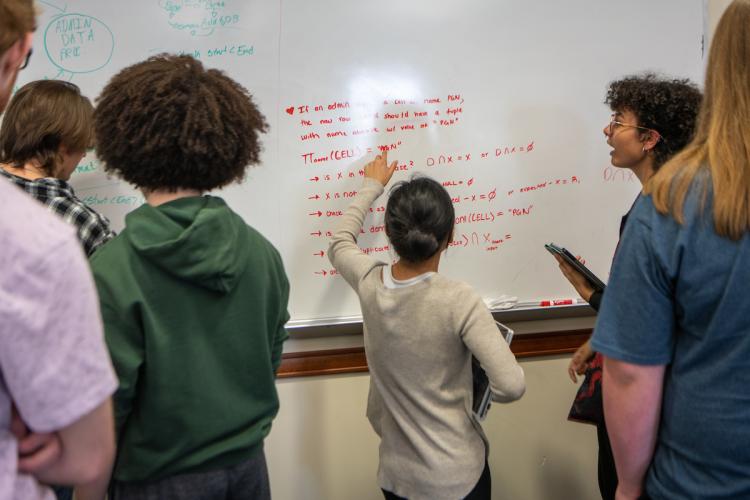
OHIO students place first, second and third in international Wikipedia editing competition

“The Wikipedia project is a way to have students reflect back on everything they’ve done in their coursework and then go to the deepest levels of Bloom’s Taxonomy of Learning to edit the articles,” Lonnie Welch, Charles R. Jr. and Marilyn Stuckey professor in the School of Electrical Engineering and Computer Science, said.
In fall 2021 and spring 2022, computer science students in Data Mining and Data Science worked toward the same goal to complete their course — to improve a Wikipedia page with more robust descriptions, key visuals and reliable sources. This common goal was part of a final project, allowing students the opportunity to revise and edit their page drafts before their final submission.
“A Wikipedia-based writing activity offers a more authentic learning experience than a traditional term paper and provides students with the opportunity to practice disseminating domain-specific knowledge to a broad audience while navigating the complexity and ambiguity of working through a real-life problem,” Welch wrote in the project’s description.
Hunter Burden, BSCS ‘21, participated in this project in both the Data Mining and Data Science course. In his final semester of his undergraduate degree in computer science, Burden worked collaboratively with his teammates to improve an article on Radar Charts, a type of graph that measures multivariate data, like performance metrics, where at least three variables are represented like spokes or points on a wheel. The culmination of his team’s hard work resulted in a first-place win in the International Society for Computational Biology’s Wikipedia Competition.
“The competition supports the ISCB's mission by promoting the improvement of topics relevant to computational biology on Wikipedia, which is widely accessed around the world as a free-to-use educational resource. Since Wikipedia is often the first port of call for someone learning about a new topic, ensuring that computational biology is well-represented on Wikipedia helps maximize the visibility and impact of the field on society,” Alastair Kilpatrick, competition organizer and bioinformatician at the University of Edinburgh, said.
While winning the competition was a benefit of this project, perhaps more importantly, the project helped assess learning outcomes, indicating that students not only learned key topics in computer science, but were also able to communicate about those topics in an informative and reliable way.
“Before we won, I felt like we did great work. Dr. Welch asked us honest questions throughout the semester about our process and the contents of the page. When we presented everything in the end, we felt really good about the result,” Burden said.
This assessment strategy was not accidental. Through collaborative work with instructional designer, Audra Anjum, Welch decided to plan his class around learning outcomes and objectives. Then he devised assessment strategies informed by his intended outcomes. He used the example of tying one's shoes to communicate his vision for his course structure.
“If someone is learning how to tie their shoes, you can either ask them a series of questions about tying shoes or you can simply ask them to tie their shoes to show you that they have learned that skill,” Welch explained.
By authoring Wikipedia pages, students were demonstrating that they learned valuable topics in computer science by writing about those topics for the layperson, creating visuals, incorporating data and identifying reliable sources that bolster their edits to the page.
“We specifically developed the Wikipedia project to not only create a unique and interesting experience [for] students, but also to demonstrate that they met the learning outcomes,” Anjum said.
Additionally, this project allowed students to practice critical written communication, a skill that is often underemphasized in both engineering and computer science coursework.
“There’s an art to writing things that are concise. You don’t want to overload people with jargon. This is an important skill in computer science when writing comments or updates on your work, so another party knows what’s going on and what their task is,” Burden said.
“You need to be able to communicate your ideas to get people excited about what you are doing. Much of the written communication we do is to sell things, ideas and ourselves. In computer science, you need to be effective at communicating requirements, designs and test plans,” Welch said.
Using their written communication skills, students collaboratively enhanced articles to improve the general landscape of Wikipedia — a resource that is often stigmatized due to the user-editable nature of each page. In this circumstance, however, students demonstrated that thoughtful, informed editing can improve the landscape of Wikipedia.
“Wikipedia has a reputation for being unreliable since so many individuals can contribute to the content. Wikipedia is a widely accessible open education resource for students and faculty, however. Experts have a responsibility to their professions to make sure that their fields are represented accurately and broadly on Wikipedia to discourage the spread of misinformation,” Anjum said.
Editing a Wikipedia page well can be a significant undertaking, but the final product results in a more informative and accessible resource for people around the globe.
“It's important for university students (and academics in general) to edit Wikipedia pages, as they possess important domain knowledge that can vastly improve Wikipedia's coverage of their subject of interest. They also should have some vested interest in ensuring that Wikipedia articles describing their subject of interest are accurate and up to date,” Kilpatrick said.
Explore the winning teams’ Wikipedia articles in Radar Charts (first place), Biological Networks (second place) and Cosegregration (third place).
To learn more about how to incorporate Wikipedia editing into curriculum design, read this article by Anjum, Kilpatrick and Welch.
